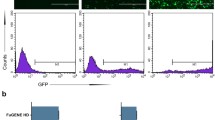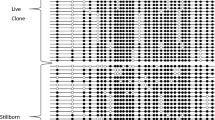Abstract
Objectives
Guangdong Small-ear Spotted (GDSS) pigs are a pig breed native to China that possesses unfortunate disadvantages, such as slow growth rate, low lean-meat percentage, and reduced feed utilization. In contrast to traditional genetic breeding methods with long cycle time and high cost, CRISPR/Cas9-mediated gene editing for the modification of the pig genome can quickly improve production traits, and therefore this technique exhibits important potential in the genetic improvement and resource development of GDSS pigs. In the present study, we aimed to establish an efficient CRISPR/Cas9-mediated gene-editing system for GDSS pig cells by optimizing the electrotransfection parameters, and to realize efficient CRISPR/Cas9-mediated gene editing of GDSS pig cells.
Results
After optimization of electrotransfection parameters for the transfection of GDSS pig cells, we demonstrated that a voltage of 150 V and a single pulse with a pulse duration of 20 ms were the optimal electrotransfection parameters for gene editing in these cells. In addition, our study generated GDSS pig single-cell colonies with biallelic mutations in the myostatin (MSTN) gene and insulin-like growth factor 2 (IGF2) intron-3 locus, which play an important role in pig muscle growth and muscle development. The single-cell colonies showed no foreign gene integration or off-target effects, and maintained normal cell morphology and viability. These gene-edited, single-cell colonies can in the future be used as donor cells to generate MSTN- and IGF2-edited GDSS pigs using somatic cell nuclear transfer (SCNT).
Conclusions
This study establishes the foundation for genetic improvement and resource development of GDSS pigs using CRISPR/Cas9-mediated gene editing combined with SCNT.






Similar content being viewed by others
References
Bi YZ, Hua ZD, Liu XM, Hua WJ, Ren HR, Xiao HM, Zhang LP, Li L, Wang ZR, Laible G, Wang Y, Dong FM, Zheng XM (2016) Isozygous and selectable marker-free MSTN knockout cloned pigs generated by the combined use of CRISPR/Cas9 and Cre/LoxP. Sci Rep 6:31729. https://doi.org/10.1038/srep31729
Burkard C, Lillico SG, Reid E, Jackson B, Mileham AJ, Ait-Ali T, Whitelaw CB, Archibald AL (2017) Precision engineering for PRRSV resistance in pigs: macrophages from genome edited pigs lacking CD163 SRCR5 domain are fully resistant to both PRRSV genotypes while maintaining biological function. PLoS Pathog 13(2):e1006206. https://doi.org/10.1371/journal.ppat.1006206
Gao Q, Wang M, Yu C, Huang L, Zheng X, Zhu Y (2014) Optimization of the electroporation conditions for DNA transformation of Staphylococcus carnosus. In: Zhang TC, Ouyang P, Kaplan S, Skarnes B (eds) Proceedings of the 2012 International Conference on Applied Biotechnology (ICAB 2012). Lecture Notes in Electrical Engineering, vol 251, Springer, Berlin, Heidelberg, pp 1699–1707.
Grobet L, Martin LJR, Poncelet D, Pirottin D, Brouwers B, Riquet J, Schoeberlein A, Dunner S, Menissier F, Massabanda J, Fries R, Hanset R, Georges M (1997) A deletion in the bovine myostatin gene causes the double–muscled phenotype in cattle. Nat Genet 17(1):71–74. https://doi.org/10.1038/ng0997-71
Guo H, Hao R, Wei Y, Sun D, Sun S, Zhang Z (2012) Optimization of electrotransfection conditions of mammalian cells with different biological features. J Membr Biol 245(12):789–795. https://doi.org/10.1007/s00232-012-9480-0
Hui SW (1995) Effects of pulse length and strength on electroporation efficiency. Methods Mol Biol 48:29–40. https://doi.org/10.1385/0-89603-328-7:29
Kambadur R, Sharma M, Smith TP, Bass J (1997) Mutations in myostatin (GDF8) in double-muscled Belgian blue and Piedmontese cattle. Genome Res 7(9):910–916. https://doi.org/10.1101/gr.7.9.910
Karra D, Dahm R (2010) Transfection techniques for neuronal cells. J Neurosci 30(18):6171–6177. https://doi.org/10.1523/JNEUROSCI.0183-10.2010
Kim TK, Eberwine JH (2010) Mammalian cell transfection: the present and the future. Anal Bioanal 397(8):3173–3178. https://doi.org/10.1007/s00216-010-3821-6
Liu X, Liu H, Wang M, Li R, Zeng J, Mo D, Cong PQ, Liu XH, Chen YS, He ZY (2018) Disruption of the ZBED6 binding site in intron 3 of IGF2 by CRISPR/Cas9 leads to enhanced muscle development in liang guang small spotted pigs. Transgenic Res. https://doi.org/10.1007/s11248-018-0107-9
McCoy AM, Collins ML, Ugozzoli LA (2010) Using the gene Pulser MXcell electroporation system to transfect primary cells with high efficiency. J Vis Exp 35:1662. https://doi.org/10.3791/1662
McPherron AC, Lee SJ (1997) Double muscling in cattle due to mutations in the myostatin gene. Proc Natl Acad Sci USA 94(23):12457–12461. https://doi.org/10.1073/pnas.94.23.12457
Mosher DS, Quignon P, Bustamante CD, Sutter NB, Mellersh CS, Parker HG, Ostrander EA (2007) A mutation in the myostatin gene increases muscle mass and enhances racing performance in heterozygote dogs. PLoS Genet 3(5):e79. https://doi.org/10.1371/journal.pgen.0030079
Nie JY, Zhu XX, Xie BK, Nong SQ, Ma QY, Xu HY, Yang XG, Lu YQ, Lu KH, Liao YY, Lu SS (2016) Successful cloning of an adult breeding boar from the novel Chinese Guike No. 1 swine specialized strain. 3 Biotech 6(2):218.
Petersen B (2017) Basics of genome editing technology and its application in livestock species. Reprod Domest Anim 52(Suppl. 3):4–13. https://doi.org/10.1111/rda.13012
Phez E, Faurie C, Golzio M, Teissié J, Rols MP (2005) New insights in the visualization of membrane permeabilization and DNA/membrane interaction of cells submitted to electric pulses. BBA-Biomembr 1724(3):248–254. https://doi.org/10.1016/j.bbagen.2005.04.005
Potter H, Heller R (2018) Transfection by electroporation. Curr Protoc Mol Biol 121:9.3.1–9.3.13.
Qian L, Tang M, Yang J, Wang Q, Cai C, Jiang S, Li H, Jiang K, Gao P, Ma D, Chen Y, An X, Li K, Cui W (2015) Targeted mutations in myostatin by zinc-finger nucleases result in double-muscled phenotype in Meishan pigs. Sci Rep 5:14435. https://doi.org/10.1038/srep14435
Ruan JX, Xu J, Chen-Tsai RY, Li K (2017) Genome editing in livestock: are we ready for a revolution in animal breeding industry? Transgenic Res 26:715–726. https://doi.org/10.1007/s11248-017-0049-7
Rust A, Hassan HH, Sedelnikova S, Niranjan D, Hautbergue G, Abbas SA, Partridge L, Rice D, Binz T, Davletov B (2015) Two complementary approaches for intracellular delivery of exogenous enzymes. Sci Rep 5:12444. https://doi.org/10.1038/srep12444
Wang K, Ouyang H, Xie Z, Yao C, Guo N, Li M (2015) Efficient generation of myostatin mutations in pigs using the CRISPR/Cas9 system. Sci Rep 5:16623. https://doi.org/10.1038/srep16623
Wang R, Zhang JY, Lu KH, Lu SS, Zhu XX (2019a) Efficient generation of GHR knockout Bama minipig fibroblast cells using CRISPR/Cas9-mediated gene editing. Vitro Cell Dev Biol Anim 55(10):784–792. https://doi.org/10.1007/s11626-019-00397-6
Wang XF, Zhu XX, Liang XW, Xu HY, Liao YY, Lu KH, Lu SS (2019b) Effects of resveratrol on in vitro maturation of porcine oocytes and subsequent early embryonic development following somatic cell nuclear transfer. Reprod Domest Anim 54(9):1195–1205. https://doi.org/10.1111/rda.13493
Whitworth KM, Lee K, Benne JA, Beaton BP, Spate LD, Murphy SL, Samuel MS, Mao J, O'Gorman C, Walters EM, Murphy CN, Driver J, Mileham A, McLaren D, Wells KD, Prather RS (2014) Use of the CRISPR/Cas9 system to produce genetically engineered pigs from in vitro-derived oocytes and embryos. Biol Reprod 91(3):78. https://doi.org/10.1095/biolreprod.114.121723
Whitworth KM, Rowland RRR, Ewen CL, Trible BR, Kerrigan MA, Cino-Ozuna AG, Samuel MS, Lightner JE, McLaren DG, Mileham AJ, Wells KD, Prather RS (2016) Gene-edited pigs are protected from porcine reproductive and respiratory syndrome virus. Nat Biotechnol 34(1):20–22. https://doi.org/10.1038/nbt.3434
Xiang G, Ren J, Hai T, Fu R, Yu D, Wang J, Li W, Wang H, Zhou Q (2018) Editing porcine IGF2 regulatory element improved meat production in Chinese Bama pigs. Cell Mol Life Sci 75(24):4619–4628. https://doi.org/10.1007/s00018-018-2917-6
Xie Z, Pang D, Yuan H, Jiao H, Lu C, Wang K, Yang Q, Li M, Chen X, Yu T, Chen X, Dai Z, Peng Y, Tang X, Li Z, Wang T, Guo H, Li L, Tu C, Lai L, Ouyang H (2018) Genetically modified pigs are protected from classical swine fever virus. PloS Pathog 14(12):e1007193. https://doi.org/10.1371/journal.ppat.1007193
Younis S, Schönke M, Massart J, Hjortebjerg R, Sundström E, Gustafson U, Björnholm M, Krook A, Frystyk J, Zierath JR, Andersson L (2018) The ZBED6-IGF2 axis has a major effect on growth of skeletal muscle and internal organs in placental mammals. Proc Natl Acad Sci USA 115(9):E2048–E2057. https://doi.org/10.1073/pnas.1719278115
Zheng Q, Lin J, Huang J, Zhang H, Zhang R, Zhang X, Cao C, Hambly C, Qin G, Yao J, Song R, Jia Q, Wang X, Li Y, Zhang N, Piao Z, Ye R, Speakman JR, Wang H, Zhou Q, Wang Y, Jin W, Zhao J (2017) Reconstitution of UCP1 using CRISPR/Cas9 in the white adipose tissue of pigs decreases fat deposition and improves thermogenic capacity. Proc Natl Acad Sci USA 114(45):E9474–E9482. https://doi.org/10.1073/pnas.1707853114
Zhu XX, Nie JY, Quan SN, Xu HY, Yang XG, Lu YQ, Lu KH, Lu SS (2016) In vitro production of cloned and transgenic cloned embryos from Guangxi Huangjiang Xiang pig. Vitro Cell Dev Biol Anim 52:137–143. https://doi.org/10.1007/s11626-015-9957-0
Zhu XX, Wei YY, Zhan QM, Yan AF, Feng J, Liu L, Tang DS (2020) CRISPR/Cas9-mediated biallelic knockout of IRX3 reduces the production and survival of somatic cell-cloned Bama minipigs. Animals 10(3):501. https://doi.org/10.3390/ani10030501
Zhu XX, Zhong YZ, Ge YW, Lu KH, Lu SS (2018a) CRISPR/Cas9-mediated generation of Guangxi Bama Minipigs harboring three mutations in α-synclein causing Parkinson’s disease. Sci Rep 8(1):12420. https://doi.org/10.1038/s41598-018-30436-3
Zhu XX, Zhong YZ, Ge YW, Lu KH, Lu SS (2018b) Generation of transgenic-cloned Huanjiang Xiang pigs systemically expressing enhanced green fluorescent protein. Reprod Domest Anim 53(6):1546–1554. https://doi.org/10.1111/rda.13301
Zu Y, Huang S, Lu Y, Liu X, Wang S (2016) Size specific transfection to mammalian cells by micropillar array electroporation. Sci Rep 6(1):38661. https://doi.org/10.1038/srep38661
Acknowledgements
This work was jointly supported by the National Science and Technology Major Project (2009ZX08010-023B, 2018ZX08010-08B), Guangdong Provincial R&D Project in Key Areas (2018B020203003), Foshan Science and Technology Innovation Project (2017AG100111) and Open Project of Guangdong Provincial Key Laboratory of Animal Molecular Design and Precise Breeding (2018A05), Guangdong Foundation and Applied Basic Research Fund (2019A1515110280), and Guangzhou Science and Technology Planning Project (201707020007).
Author information
Authors and Affiliations
Contributions
DST and XXZ conceived and designed the experiments. YYW, QMZ and XXZ conducted the experiments and analyzed the results. DST, XXZ, YYW and QMZ drafted the manuscript. JHL and all other authors participated in discussions of the results and revised the manuscript.
Corresponding authors
Ethics declarations
Conflicts of interest
All authors declare no financial and non-financial conflict of interest.
Clarification on animal ethics
All of the animal procedures used in this study were approved by the Animal Care & Welfare Committee of Foshan University (approval no. 2019020). All of the surgical procedures were performed under anesthesia by a veterinarian, and all efforts were made to minimize animal suffering.
Additional information
Publisher's Note
Springer Nature remains neutral with regard to jurisdictional claims in published maps and institutional affiliations.
Rights and permissions
About this article
Cite this article
Wei, Yy., Zhan, Qm., Zhu, Xx. et al. Efficient CRISPR/Cas9-mediated gene editing in Guangdong small-ear spotted pig cells using an optimized electrotransfection method. Biotechnol Lett 42, 2091–2109 (2020). https://doi.org/10.1007/s10529-020-02930-0
Received:
Accepted:
Published:
Issue Date:
DOI: https://doi.org/10.1007/s10529-020-02930-0




